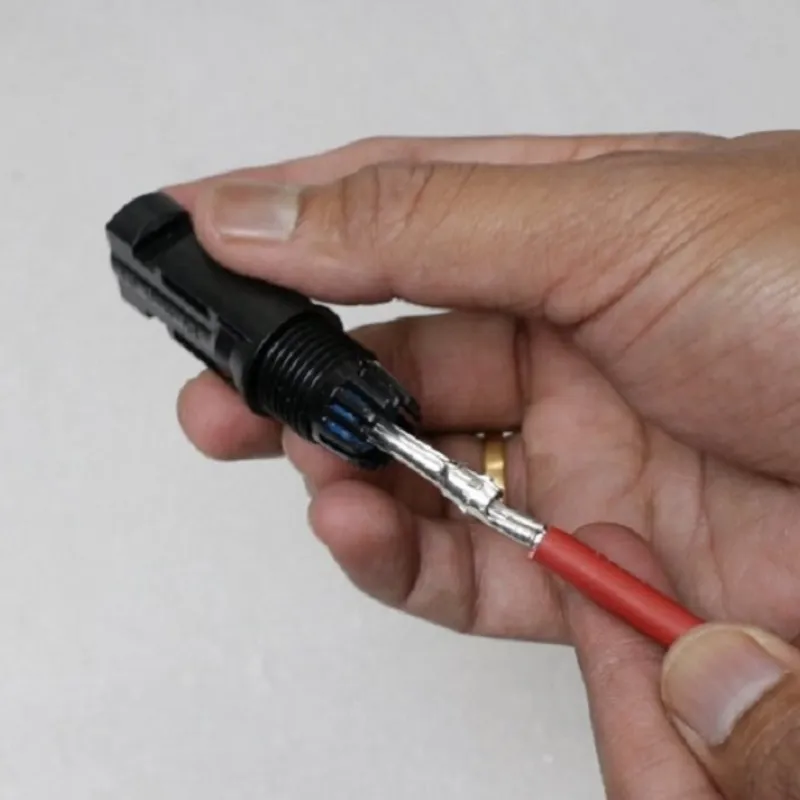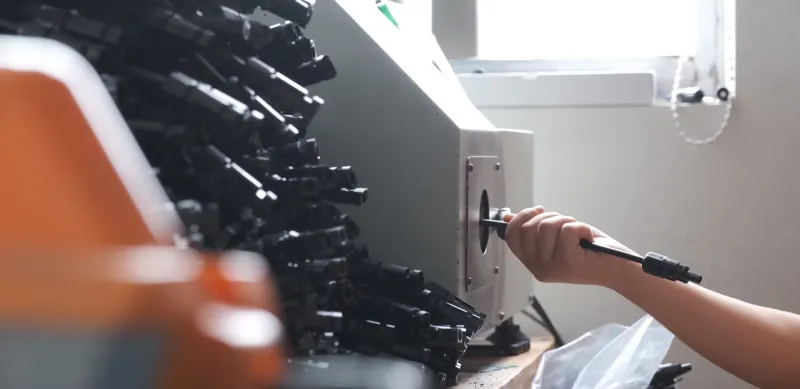ແນະນຳ
In any solar panel system, while the panels themselves capture the sun’s energy, it’s the smaller components that ensure this power flows safely and efficiently. Among these critical parts, the solar connector is the standard, linking panels together and connecting them to the rest of your system. But here’s a crucial point often overlooked: not all solar connectors are suitable for every situation. Making the wrong choice can lead to significant power loss, premature system failure, and even dangerous electrical hazards like fires. This guide will show you exactly how to select the right solar connector for your specific solar project, ensuring a safe, reliable, and long-lasting renewable energy investment.
Understanding Solar Connectors: The Basics
What Exactly is a Solar Connector?
Solar connector refers to a type of single-contact electrical connector commonly used for connecting solar panels. They come in male and female pairs that lock together, forming a robust and weather-resistant seal. These connectors are designed to handle the specific electrical requirements and environmental conditions of solar installations.
ເປັນຫຍັງພວກມັນຈຶ່ງຈຳເປັນສຳລັບລະບົບແຜງແສງອາທິດ?
ຕົວເຊື່ອມຕໍ່ເຫຼົ່ານີ້ແມ່ນມາດຕະຖານອຸດສາຫະກໍາສໍາລັບເຫດຜົນທີ່ສໍາຄັນຫຼາຍ:
- ການເຊື່ອມຕໍ່ກັນ: ພວກເຂົາສະຫນອງວິທີທີ່ງ່າຍດາຍ, ເຊື່ອຖືໄດ້ເພື່ອເຊື່ອມຕໍ່ແຜງແສງຕາເວັນຫຼາຍອັນຮ່ວມກັນເປັນຊຸດ (ເພື່ອເພີ່ມແຮງດັນ) ຫຼືຂະຫນານ (ເພື່ອເພີ່ມປະຈຸບັນ).
- Weather Resistance: Genuine solar connectors are designed with seals that protect the electrical connection from moisture, dust, and UV radiation, making them suitable for harsh outdoor environments.
- ຄວາມປອດໄພ: ກົນໄກການລັອກຂອງພວກມັນປ້ອງກັນບໍ່ໃຫ້ເກີດການຕັດການເຊື່ອມຕໍ່ໂດຍບັງເອີນ, ເຊິ່ງເປັນສິ່ງສໍາຄັນຫຼາຍເພາະວ່າແຜງພະລັງງານແສງອາທິດສາມາດສ້າງແຮງດັນໄຟຟ້າ DC ທີ່ເປັນອັນຕະລາຍເຖິງແມ່ນວ່າຢູ່ໃນແສງສະຫວ່າງຫນ້ອຍ. ການຕິດຕໍ່ທີ່ຫຸ້ມຫໍ່ຍັງຊ່ວຍຫຼຸດຜ່ອນຄວາມສ່ຽງຕໍ່ການຊ໊ອກໄຟຟ້າ.
Key Factors for Choosing the Right Solar Connector
ການປະເມີນຄ່າໄຟຟ້າ: ການຈັບຄູ່ແຮງດັນ ແລະກະແສໄຟຟ້າ
Every solar panel and system has maximum voltage (often listed as Voc – Open Circuit Voltage) and current (Isc – Short Circuit Current, or Imp – Maximum Power Current) specifications. Your chosen solar connector must have voltage and current ratings that meet or exceed these system maximums.
ການປະເມີນຄ່າແຮງດັນ: ກວດເບິ່ງແຜ່ນຂໍ້ມູນຂອງຕົວເຊື່ອມຕໍ່ສໍາລັບລະດັບແຮງດັນໄຟຟ້າ DC ສູງສຸດຂອງມັນ (ຕົວຢ່າງ: 1000VDC, 1500VDC). ອັນນີ້ຕ້ອງສູງກວ່າແຮງດັນລະບົບສູງສຸດຂອງອາເລແສງຕາເວັນຂອງເຈົ້າ.
ການຈັດອັນດັບປະຈຸບັນ: ເຊັ່ນດຽວກັນ, ອັດຕາການລ້າສູງສຸດຂອງຕົວເຊື່ອມຕໍ່ (e. g. 30A, 50A) ຈະຕ້ອງຫຼາຍກວ່າກະແສໄຟຟ້າສູງສຸດທີ່ໄຫຼຜ່ານມັນ.
Consequence of Mismatch: Using underrated connectors is extremely dangerous. Excessive current can cause overheating, melting the connector housing, leading to connection failure and posing a significant fire risk. An underrated voltage connector can fail under high voltage conditions, causing arcing. Always check the solar connector voltage rating and solar connector current rating against your system specs.
ຄວາມເຂົ້າກັນໄດ້ຂອງ Wire Gauge (AWG/mm²)
Solar connectors are designed to be used with specific sizes of solar cable, typically expressed in American Wire Gauge (AWG) or square millimeters (mm²). Common compatible sizes include 12 AWG (approx. 4mm²) and 10 AWG (approx. 6mm²).
Match the Connector to the Cable: Ensure the solar connector wire gauge compatibility listed on the connector’s datasheet matches the gauge of the solar wire you are using. The internal metal contact pin must be correctly sized for the wire conductor, and the back sealing nut must properly grip the outer insulation.
ຜົນສະທ້ອນຂອງການບໍ່ກົງກັນ: ການນໍາໃຊ້ຕົວເຊື່ອມຕໍ່ທີ່ອອກແບບມາສໍາລັບສາຍຂະຫນາດໃຫຍ່ກ່ຽວກັບສາຍຂະຫນາດນ້ອຍກວ່າ (ຫຼືໃນທາງກັບກັນ) ຈະເຮັດໃຫ້ crimp ບໍ່ດີ. ນີ້ນໍາໄປສູ່ການຕໍ່ຕ້ານໄຟຟ້າສູງ (ເຮັດໃຫ້ເກີດຄວາມຮ້ອນແລະການສູນເສຍພະລັງງານ) ແລະປະນີປະນອມປະທັບຕາ weatherproof, ອະນຸຍາດໃຫ້ ingress ຄວາມຊຸ່ມແລະຄວາມລົ້ມເຫຼວໃນທີ່ສຸດ.
ຄວາມເຂົ້າກັນໄດ້ຂອງຕົວເຊື່ອມຕໍ່: ຮັບປະກັນຄວາມສອດຄ່ອງທີ່ສົມບູນແບບ
This is arguably one of the most critical, yet frequently ignored, aspects of solar connector compatibility.
The Golden Rule: Always use mating male and female connectors that are from the exact same manufacturer and the exact same product type (e.g., Staubli solar connector with Staubli solar connector, Amphenol H4 with Amphenol H4).
Why mixing is bad: Many ask, “are all solar connectors the same?” The definitive answer is NO. Even if connectors from different brands seem to click together, subtle differences in dimensions, materials, and sealing mechanisms exist. Mixing brands can lead to:
- ການປະທັບຕາທີ່ບໍ່ຖືກຕ້ອງ, ອະນຸຍາດໃຫ້ນ້ໍາເສຍຫາຍແລະການກັດກ່ອນ.
- ການຕິດຕໍ່ໄຟຟ້າບໍ່ດີ, ເຮັດໃຫ້ເກີດຄວາມຕ້ານທານ, ຄວາມຮ້ອນ, ແລະອາດມີ arcing (ຄວາມສ່ຽງໄຟ).
- ການຮັບປະກັນຂອງຜູ້ຜະລິດຖືກຍົກເລີກສໍາລັບທັງຕົວເຊື່ອມຕໍ່ແລະອາດຈະເປັນແຜງ.
- ການບໍ່ປະຕິບັດຕາມລະຫັດໄຟຟ້າ (ເຊັ່ນ: NEC ໃນສະຫະລັດຫຼື CEC ໃນການາດາ).
ຜົນສະທ້ອນຂອງຄວາມບໍ່ສອດຄ່ອງ: ອາຍຸການຂອງລະບົບຫຼຸດລົງ, ອັນຕະລາຍດ້ານຄວາມປອດໄພທີ່ອາດຈະເກີດຂຶ້ນ, ແລະການຮັບປະກັນທີ່ບໍ່ຖືກຕ້ອງ. ຢ່າສ່ຽງ – ໃຊ້ຄູ່ທີ່ຈັບຄູ່ຈາກຜູ້ຜະລິດ ແລະປະເພດດຽວກັນສະເໝີ. ກວດເບິ່ງຕົວເຊື່ອມຕໍ່ສໍາລັບຍີ່ຫໍ້.
ຄຸນນະພາບ ແລະ ການຢັ້ງຢືນ: ເຫັນຂອງແທ້ທຽບກັບຂອງປອມ
The market is unfortunately flooded with cheap, low-quality, and counterfeit solar connectors. Using genuine solar connectors from reputable manufacturers is paramount for safety and longevity.
ຊອກຫາການຢັ້ງຢືນ: ໃຫ້ແນ່ໃຈວ່າຕົວເຊື່ອມຕໍ່ໄດ້ຮັບການຢັ້ງຢືນໂດຍອົງການທີ່ໄດ້ຮັບການຍອມຮັບເຊັ່ນ UL (Underwriters Laboratories) ຫຼື TÜV Rheinland. ການຢັ້ງຢືນເຫຼົ່ານີ້ຊີ້ບອກວ່າຕົວເຊື່ອມຕໍ່ໄດ້ຜ່ານການທົດສອບຄວາມປອດໄພ ແລະປະສິດທິພາບຢ່າງເຄັ່ງຄັດ. ປົກກະຕິແລ້ວເຄື່ອງໝາຍຈະເຫັນໄດ້ຢູ່ໃນຕົວເຊື່ອມຕໍ່.
Physical Inspection: Genuine connectors generally feel more robust, have clear markings, use higher-quality plastics and metals, and feature a precise, reliable locking mechanism. Fake solar connectors often feel flimsy, have poorly defined markings, and may not lock securely.
ຜົນສະທ້ອນຂອງຄຸນນະພາບທີ່ບໍ່ດີ: ຕົວເຊື່ອມຕໍ່ປອມມັກຈະໃຊ້ວັດສະດຸທີ່ຕໍ່າກວ່າທີ່ຊຸດໂຊມໄວພາຍໃຕ້ການສໍາຜັດ UV, ບໍ່ຮັກສາປະທັບຕາກັນນ້ໍາ, ມີການຕິດຕໍ່ໄຟຟ້າທີ່ບໍ່ດີເຮັດໃຫ້ຄວາມຕ້ານທານແລະຄວາມຮ້ອນສູງ, ແລະສາມາດເປັນຄວາມຮັບຜິດຊອບດ້ານຄວາມປອດໄພທີ່ຮ້າຍແຮງ.
ການປົກປ້ອງສິ່ງແວດລ້ອມ: ຄວາມເຂົ້າໃຈການຈັດອັນດັບ IP
Solar connectors are designed for outdoor use and must withstand the elements. Their level of protection against solids (like dust) and liquids (like water) is indicated by an Ingress Protection (IP) rating.
ການຈັດອັນດັບທົ່ວໄປ: ໂດຍທົ່ວໄປແລ້ວທ່ານຈະເຫັນການຈັດອັນດັບເຊັ່ນ IP67 (ກັນຝຸ່ນ ແລະ ປ້ອງກັນການແຊ່ນ້ໍາຊົ່ວຄາວ) ຫຼື IP68 (ກັນຝຸ່ນ ແລະປ້ອງກັນການແຊ່ນ້ໍາຢ່າງຕໍ່ເນື່ອງພາຍໃຕ້ເງື່ອນໄຂທີ່ລະບຸໄວ້).
Choose Appropriately: For most rooftop and ground-mount solar installations, IP67 is generally sufficient, but IP68 offers a higher level of protection, especially in very wet environments. Check the IP rating solar connectors offer before purchasing.
ຜົນສະທ້ອນຂອງການປະເມີນບໍ່ພຽງພໍ: ການເຊື່ອມຕໍ່ທີ່ມີການຈັດອັນດັບ IP ບໍ່ພຽງພໍສໍາລັບສະພາບແວດລ້ອມສາມາດອະນຸຍາດໃຫ້ຄວາມຊຸ່ມຊື່ນແລະຂີ້ຝຸ່ນ ingress, ນໍາໄປສູ່ການກັດກ່ອນ, ວົງຈອນສັ້ນ, ແລະຄວາມລົ້ມເຫຼວຂອງການເຊື່ອມຕໍ່ໃນໄລຍະເວລາ.
Common Mistakes to Avoid When Selecting Solar Connectors
Selecting the wrong solar connector is easier than you might think. But wait—there’s good news! You can avoid major headaches by sidestepping these common pitfalls:
- ຄວາມຜິດພາດແບບປະສົມແລະກົງກັນ: ການນໍາໃຊ້ຕົວເຊື່ອມຕໍ່ຈາກຍີ່ຫໍ້ຕ່າງໆຫຼືປະເພດຕ່າງໆຮ່ວມກັນ. ຈືຂໍ້ມູນການ: ມີພຽງແຕ່ຕົວເຊື່ອມຕໍ່ຄູ່ຈາກຜູ້ຜະລິດດຽວກັນແລະສາຍຜະລິດຕະພັນສະເພາະ.
- ການບໍ່ສົນໃຈຕົວເລກ: ລົ້ມເຫລວໃນການກວດສອບວ່າແຮງດັນຂອງຕົວເຊື່ອມຕໍ່ແລະການຈັດອັນດັບປະຈຸບັນຕອບສະຫນອງຫຼືເກີນຂໍ້ກໍານົດສູງສຸດຂອງລະບົບຂອງທ່ານ.
- ບັນຫາຂະຫນາດ (ສໍາລັບສາຍ): ການເລືອກຕົວເຊື່ອມຕໍ່ທີ່ບໍ່ໄດ້ອອກແບບໂດຍສະເພາະສໍາລັບເຄື່ອງວັດແທກສາຍໄຟແສງຕາເວັນຂອງທ່ານ (ເຊັ່ນ: ການນໍາໃຊ້ຕົວເຊື່ອມຕໍ່ 10 AWG ໃນສາຍ 12 AWG).
- Going Cheap: Opting for uncertified, visibly low-quality, or fake solar connectors to save a few dollars – this compromises safety and system reliability.
- ຄວາມສ່ຽງຕໍ່ການລີໄຊເຄີນ: ນຳໃຊ້ຕົວເຊື່ອມຕໍ່ຄືນໃໝ່ທີ່ເສຍຫາຍຢ່າງເຫັນໄດ້ຊັດ, ມີຮອຍແຕກ, ຜິດປົກກະຕິ, ຫຼືຖືກສະພາບອາກາດຢ່າງໜັກໜ່ວງ. ຕົວເຊື່ອມຕໍ່ແມ່ນຂ້ອນຂ້າງລາຄາຖືກ; ທົດແທນຜູ້ຕ້ອງສົງໄສໃດຫນຶ່ງ.
Tools Needed for Proper Solar Connector Installation
ມີຕົວເຊື່ອມຕໍ່ທີ່ຖືກຕ້ອງແມ່ນພຽງແຕ່ເຄິ່ງຫນຶ່ງຂອງການສູ້ຮົບ; ການຕິດຕັ້ງທີ່ເຫມາະສົມແມ່ນສໍາຄັນ. ໃນຂະນະທີ່ຄູ່ມືນີ້ເນັ້ນໃສ່ການເລືອກ, ຈົ່ງຈື່ໄວ້ວ່າທ່ານຕ້ອງການເຄື່ອງມືສະເພາະສໍາລັບການຕິດຕັ້ງ:
- Correct Crimping Tool: This is NON-NEGOTIABLE. Use a crimper specifically designed for the make and model of the solar connector pins you are using and the wire gauge. Generic electrical pliers will NOT create a safe, reliable, low-resistance crimp.
- Wire Strippers: ເພື່ອເອົາ insulation ໄດ້ຢ່າງຖືກຕ້ອງໂດຍບໍ່ມີການ nicking ຕົວ conductors ສາຍ.
- ເຄື່ອງມືປະກອບຕົວເຊື່ອມຕໍ່/ຖອດປະກອບ: ເລື້ອຍໆ wrenches ພາດສະຕິກອອກແບບມາເພື່ອ tighten nut ດ້ານຫລັງຢ່າງປອດໄພແລະບາງຄັ້ງຈໍາເປັນຕ້ອງໄດ້ປົດລັອກ connectors.
Safety First: Critical Considerations for Solar Connectors
ການຈັດການພາກສ່ວນໃດນຶ່ງຂອງລະບົບໄຟຟ້າແສງຕາເວັນຮຽກຮ້ອງໃຫ້ມີຄວາມລະມັດລະວັງ. ຈື່ໄວ້ຈຸດຄວາມປອດໄພຂອງຕົວເຊື່ອມຕໍ່ແສງອາທິດເຫຼົ່ານີ້:
- ຢ່າເຊື່ອມຕໍ່ ຫຼືຕັດການເຊື່ອມຕໍ່ພາຍໃຕ້ການໂຫຼດ: ແຜງແສງອາທິດຜະລິດກະແສໄຟຟ້າເມື່ອຖືກແສງ. ການຕັດການເຊື່ອມຕໍ່ວົງຈອນສົດສາມາດເຮັດໃຫ້ເກີດອັນຕະລາຍໄດ້. ສະເຫມີ de-energize ວົງຈອນທໍາອິດ (ເຊັ່ນ: ຝາປິດ, ໃຊ້ DC disconnects).
- ຮັບປະກັນການມີສ່ວນພົວພັນເຕັມທີ່: ຍູ້ຕົວເຊື່ອມຕໍ່ເຂົ້າກັນຢ່າງແໜ້ນໜາຈົນກວ່າເຈົ້າໄດ້ຍິນ ແລະຮູ້ສຶກວ່າແຖບລັອກຖືກຄລິກເຂົ້າໃສ່. ການເຊື່ອມຕໍ່ບາງສ່ວນແມ່ນຈຸດທີ່ມີຄວາມຕ້ານທານສູງແລະຄວາມລົ້ມເຫຼວ.
- Crimping ທີ່ເຫມາະສົມແມ່ນສໍາຄັນ: ການ crimp ທີ່ບໍ່ດີແມ່ນຫນຶ່ງໃນຈຸດລົ້ມເຫຼວທົ່ວໄປທີ່ສຸດໃນການຕິດຕັ້ງແສງຕາເວັນ. ປະຕິບັດຕາມຄໍາແນະນໍາຜູ້ຜະລິດຢ່າງແນ່ນອນ.
- ກວດກາເປັນປົກກະຕິ: ກວດສອບການເຊື່ອມຕໍ່ເປັນໄລຍະສໍາລັບອາການຂອງຄວາມເສຍຫາຍ, melting, corrosion, ຫຼືການປ່ຽນສີ, ໂດຍສະເພາະແມ່ນຫຼັງຈາກເຫດການດິນຟ້າອາກາດຮ້າຍແຮງ.
Where to Buy Reliable Solar Connectors
ເພື່ອຮັບປະກັນວ່າທ່ານໄດ້ຮັບຕົວເຊື່ອມຕໍ່ທີ່ແທ້ຈິງ, ຄຸນນະພາບສູງ:
- ຜູ້ສະຫນອງອຸປະກອນແສງຕາເວັນທີ່ມີຊື່ສຽງ: ຊື້ຈາກຜູ້ຈັດຈໍາຫນ່າຍທີ່ສ້າງຕັ້ງຂຶ້ນໂດຍຊ່ຽວຊານໃນອົງປະກອບແສງຕາເວັນ.
- ໂດຍກົງຈາກຜູ້ຜະລິດ: ຖ້າເປັນໄປໄດ້, ການຊື້ໂດຍກົງຮັບປະກັນຄວາມຖືກຕ້ອງ (ຕົວຢ່າງ, Staubli, Amphenol, ແລະອື່ນໆ).
- ຫຼີກລ່ຽງແຫຼ່ງທີ່ມີຄວາມສ່ຽງ: ລະວັງລາຄາທີ່ຕໍ່າຜິດປົກກະຕິໃນຕະຫລາດອອນລາຍທົ່ວໄປທີ່ສິນຄ້າປອມມີຢູ່ທົ່ວໄປ. ບູລິມະສິດການຕິດຕາມແລະຊື່ສຽງຂອງຜູ້ສະຫນອງຫຼາຍກວ່າການປະຫຍັດຄ່າໃຊ້ຈ່າຍຫນ້ອຍທີ່ສຸດ.
ສະຫລຸບ
Choosing the appropriate solar connector might seem like a small detail in a large solar project, but it’s fundamental to the system’s safety, performance, and longevity. By carefully considering the electrical ratings, wire gauge compatibility, manufacturer compatibility, quality certifications, and environmental protection (IP rating), you can confidently select the right solar connector for your needs.
ກວດເບິ່ງແຜ່ນຂໍ້ມູນຄືນໃໝ່ສະເໝີສໍາລັບທັງແຜງພະລັງງານແສງອາທິດຂອງເຈົ້າ ແລະຕົວເຊື່ອມຕໍ່ທີ່ເຈົ້າຕັ້ງໃຈຈະໃຊ້. ຢ່າປະປົນຍີ່ຫໍ້ຕົວເຊື່ອມຕໍ່, ແລະໃຫ້ຄວາມສຳຄັນສະເໝີກ່ຽວກັບຄຸນນະພາບ ແລະຄວາມປອດໄພຫຼາຍກວ່າຄ່າໃຊ້ຈ່າຍ. ຖ້າທ່ານເຄີຍສົງໃສ, ໃຫ້ປຶກສາກັບຜູ້ຊ່ຽວຊານດ້ານການຕິດຕັ້ງແສງຕາເວັນທີ່ມີຄຸນວຸດທິ. ການໄດ້ຮັບການເຊື່ອມຕໍ່ທີ່ຖືກຕ້ອງເຮັດໃຫ້ການລົງທືນຂອງແສງຕາເວັນຂອງເຈົ້າຈະສະຫວ່າງສົດໃສສໍາລັບປີຂ້າງຫນ້າ.
Frequently Asked Questions (FAQ) about Selecting Solar Connectors
Here are answers to some common questions people have when choosing and working with solar connectors:
Q1: Are all solar connectors the same or interchangeable?
A: Absolutely not. While they may look similar, connectors from different manufacturers have variations in tolerances, materials, and sealing designs. Never mix solar connector brands or types when mating male and female ends. Doing so can lead to poor connections, moisture ingress, overheating, code violations, and voided warranties. Always use matched pairs from the same manufacturer and product line.
Q2: What happens if I use a solar connector rated for a different wire gauge than my solar cable?
A: ການນໍາໃຊ້ຕົວເຊື່ອມຕໍ່ຂະຫນາດທີ່ບໍ່ຖືກຕ້ອງສໍາລັບເຄື່ອງວັດແທກສາຍໄຟຂອງທ່ານ (ຕົວຢ່າງ: ຕົວເຊື່ອມຕໍ່ 10 AWG ຢູ່ໃນສາຍ 12 AWG) ຈະເຮັດໃຫ້ເກີດການ crimp ທີ່ບໍ່ຖືກຕ້ອງ. ນີ້ສ້າງຄວາມຕ້ານທານໄຟຟ້າສູງ, ເຊິ່ງສ້າງຄວາມຮ້ອນແລະຫຼຸດຜ່ອນປະສິດທິພາບຂອງລະບົບ. ມັນຍັງປະນີປະນອມປະທັບຕາທີ່ທົນທານຕໍ່ສະພາບອາກາດ, ອາດຈະນໍາໄປສູ່ການກັດກ່ອນແລະຄວາມລົ້ມເຫຼວຂອງຕົວເຊື່ອມຕໍ່. ຈັບຄູ່ຄວາມເຂົ້າກັນໄດ້ຂອງເຄື່ອງວັດແທກສາຍທີ່ລະບຸໄວ້ສະເໝີກັບຂະໜາດສາຍໄຟແສງຕາເວັນຂອງເຈົ້າ.
Q3: How can I tell if a solar connector is genuine and high-quality?
A: ຊອກຫາເຄື່ອງຫມາຍທີ່ຊີ້ບອກການຢັ້ງຢືນຈາກອົງການທີ່ມີຊື່ສຽງເຊັ່ນ UL ຫຼື TÜV. ຕົວເຊື່ອມຕໍ່ຂອງແທ້ມັກຈະມີຄວາມຮູ້ສຶກທີ່ເຂັ້ມແຂງ, ມີຍີ່ຫໍ້ຜູ້ຜະລິດທີ່ຈະແຈ້ງແລະຕົວເລກສ່ວນ, ແລະມີກົນໄກການລັອກທີ່ປອດໄພ. ລະວັງຕົວເຊື່ອມຕໍ່ທີ່ມີຄວາມຮູ້ສຶກອ່ອນເພຍ, ມີເຄື່ອງຫມາຍທີ່ບໍ່ຊັດເຈນ, ຫຼືຖືກຂາຍໃນລາຄາທີ່ຕໍ່າຜິດປົກກະຕິຈາກແຫຼ່ງທີ່ບໍ່ສາມາດຕິດຕາມໄດ້, ເພາະວ່າພວກມັນອາດຈະມີຄຸນນະພາບຕໍ່າຫຼືຂອງປອມ.
Q4: Do I really need a special crimping tool for solar connectors?
A: Yes, absolutely. A proper crimp is essential for a safe, low-resistance, long-lasting connection. You need a dedicated solar connector crimping tool designed specifically for the pins used by your chosen connector brand and wire size. Using standard pliers or the wrong crimper will result in a faulty connection prone to failure and overheating.
Q5: Can I reuse old solar connectors from a previous installation?
A: ໂດຍທົ່ວໄປແລ້ວມັນບໍ່ໄດ້ແນະນໍາ. ຕົວເຊື່ອມຕໍ່ເຊື່ອມໂຊມຕາມເວລາເນື່ອງຈາກການຖືກແສງ UV ແລະສະພາບອາກາດ. ກວດເບິ່ງຕົວເຊື່ອມຕໍ່ທີ່ມີຢູ່ແລ້ວຢ່າງລະມັດລະວັງສໍາລັບການແຕກ, ການຜິດປົກກະຕິ, ການກັດກ່ອນ, ຫຼືຄວາມເສຍຫາຍຕໍ່ປະທັບຕາຫຼືແຖບລັອກ. ຖ້າມີຄວາມສົງໃສກ່ຽວກັບສະພາບຂອງມັນ, ໃຫ້ປ່ຽນແທນ. ຕົວເຊື່ອມຕໍ່ແມ່ນຂ້ອນຂ້າງລາຄາຖືກເມື່ອທຽບກັບຄວາມສ່ຽງຂອງຄວາມລົ້ມເຫຼວຂອງລະບົບ.
Q6: What does the IP rating (like IP67 or IP68) mean on a solar connector?
A: ການປະເມີນ IP (Ingress Protection) ຊີ້ບອກວ່າຕົວເຊື່ອມຕໍ່ຖືກຜະນຶກເຂົ້າກັບຂອງແຂງ (ຝຸ່ນ) ແລະນໍ້າ (ນໍ້າ). ຕົວເລກທໍາອິດກ່ຽວຂ້ອງກັບການປົກປ້ອງແຂງ (6 ແມ່ນຄວາມແຫນ້ນຫນາຂອງຝຸ່ນ), ແລະຕົວເລກທີສອງກ່ຽວຂ້ອງກັບການປ້ອງກັນຂອງແຫຼວ (7 ຫມາຍເຖິງການປົກປ້ອງຈາກການແຊ່ນ້ໍາຊົ່ວຄາວ, 8 ຫມາຍເຖິງການປ້ອງກັນການແຊ່ນ້ໍາຢ່າງຕໍ່ເນື່ອງ). ການຈັດອັນດັບ IP ທີ່ສູງຂຶ້ນຫມາຍເຖິງການປົກປ້ອງສິ່ງແວດລ້ອມທີ່ດີກວ່າ, ສໍາຄັນສໍາລັບການຕິດຕັ້ງແສງຕາເວັນນອກ.
Q7: Is it safe for me to connect or disconnect solar connectors?
A: Only if the circuit is de-energized (i.e., not producing power). Never connect or disconnect solar connectors while the solar panels are exposed to light (under load). Doing so can create a dangerous electrical arc. Always ensure panels are covered or the circuit is opened via a DC disconnect switch before manipulating connectors. If unsure, consult a qualified professional.
ທີ່ກ່ຽວຂ້ອງ
How to Determine the Quality of Solar Connectors: 7 Essential Indicators
Solar Connector Factory Direct Sales vs. Trading Company: Which Is Right for Your Procurement Needs?
Solar Connector Manufacturing Process: A Comprehensive Explanation





